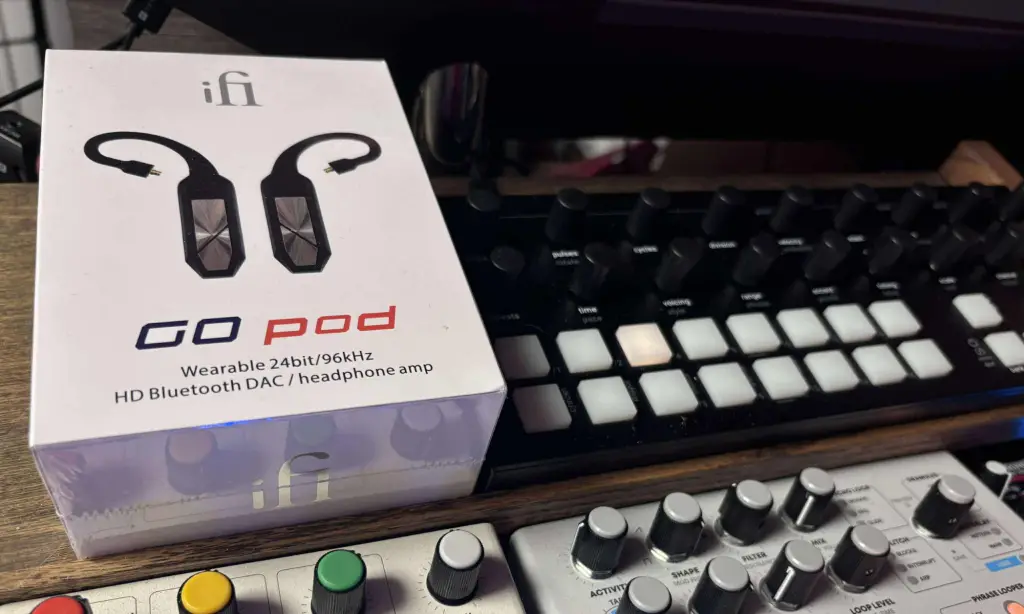Table of Contents
I get it — there’s always a trade-off between portability and performance when it comes to wireless audio. But with the GO pod, iFi claims to have found a solution that lets you go completely wireless without sacrificing sound quality. They say it isn’t your typical Bluetooth earbud setup. The GO pod turns your high-end in-ear monitors (IEMs) into a wireless system that rivals most wired configurations. But while the GO pod excels in many ways, it’s not without some quirks and limitations.
At its core, the GO pod is a Bluetooth DAC/headphone amp designed for audiophiles who are tired of dealing with wires but don’t want to compromise on sound quality. It offers Hi-Res 96kHz/24-bit wireless audio and supports leading codecs like LDAC, aptX HD, and features Qualcomm Snapdragon Sound. Snapdragon Sound is not a codec itself but a broader technology designed to enhance Bluetooth audio quality, including support for aptX Voice, which improves voice clarity. For audiophiles, these features help ensure a more robust and detailed listening experience. Of course, at $399, the GO pod sits in a different price bracket than your average true wireless earbuds, and that’s something worth considering, especially in this day and age.
So, who’s this for? It’s clear that iFi made the GO pod for those of us who aren’t willing to settle for overly compressed and flat audio that most wireless earbuds offer. Whether you’re commuting, traveling, or just lounging at home, the GO pod lets you go cable-free while still enjoying the full range of your IEM’s performance. But this premium experience does come with some trade-offs, which we’ll explore further.
Design and Build Quality
First impressions matter, and the GO pod makes a solid one. The design is sleek and functional, with each pod weighing just 12-ish grams. That’s light enough to forget you’re wearing them after a while, but enough that they “feel” durable. The ear loop design helps distribute the weight evenly, more or less, so you won’t feel pressure building up after longer listening sessions.
That said, not everyone will find the ear loops to be perfect as they aren’t a conventional design by any means. The rubber material used is somewhat stiff, which might cause discomfort for those with larger or more sensitive ears. The fit is secure, but the rigidity of the hooks means they aren’t as forgiving as softer, more flexible designs on the market these days. While they won’t fall off during exercise, the initial adjustment might be tricky for some, especially during long flights or extended use. All this being said, I know they have recently updated the ear loops to be softer, which easily could remedy this issue (I just cannot speak with complete confidence as I reviewed versions with more rigid designs).
That being said, the build quality is undeniably solid.
The GO pod features an aluminum front panel, high-end components like TDK C0G ceramic capacitors, and a Qualcomm QCC5144 Bluetooth module. However, the case is a bit of a mixed bag. The 1500mAh battery inside provides great longevity, with up to 35 hours of total playtime. But the case itself is quite bulky, which makes it less pocket-friendly compared to other wireless earbud cases I have around the studio. It feels like something you’ll want to carry in a backpack, not your jeans. While the Qi wireless charging and USB-C fast charging options are welcome, the size of the case might deter you from taking it everywhere.
Compatibility and Connectivity

One of the GO pod’s biggest strengths is its versatility.
Right out of the box, it supports 0.78mm 2-pin and MMCX connectors, which cover a huge range of popular IEMs. If you’ve got IEMs with less common connections like Pentaconn, T2, or A2DC, you can buy adapters separately. This is great if you’re someone with multiple IEMs in your collection like myself. But here’s where one of the first downsides comes in: these additional adapters aren’t included, and they’ll cost you extra, which might be frustrating at this price point.
On the Bluetooth side, iFi packed the GO pod with every codec you could want. It supports LDAC, aptX HD, aptX Adaptive, AAC, and even Qualcomm Snapdragon Sound, which delivers fantastic audio streaming quality that I mentioned in the earlier sections of the article. Bluetooth 5.2 ensures that your connection stays stable, even if you’re moving around the house. But it’s worth noting that while the Bluetooth range is generally good, there have been occasional connection quirks with some devices. I myself never experienced any issue, but I have heard some of users reporting having to re-pair the pods if one loses connection, which can interrupt the seamless experience iFi claims to have.
They’ve also made some big upgrades to the firmware here which seeks to alleviate many of the connectivity hesitations I had while reviewing these.
Performance Breakdown

When it comes to performance, the GO pod shines in some areas and shows its limitations in others. The Qualcomm QCC5144 Bluetooth module ensures low power consumption while keeping the audio signal strong. The TrueWireless Mirroring technology allows seamless switching between the two pods, ensuring a stable connection even if you’re moving around. That said, connection dropouts do happen from time to time, particularly in environments with heavy Bluetooth interference, like crowded airports or urban areas.
The DAC stage, powered by Cirrus Logic MasterHIFI chips, is the GO pod’s strong suit.
This separates it from most true wireless earbuds that integrate Bluetooth, DAC, and amplification into a single chip. The GO pod’s dedicated DAC and amplification stages help reduce distortion and improve dynamic range. But while the audio quality is top-tier for wireless, the GO pod doesn’t completely escape the limitations of Bluetooth technology. You’ll still get occasional compression artifacts if you’re not using a codec like LDAC, especially with complex music.

Audio Quality Analysis
Let’s get to the heart of the matter: how does it sound? The GO pod delivers fantastic audio for a wireless setup, bringing out the best in your IEMs. Everything from the low-end punch of a good bass line to the shimmering highs of a cymbal comes through with clarity and detail.
It’s clear that iFi put in the work to make this sound like a proper wired setup, even though it’s wireless.
However, it’s important to manage expectations. While the GO pod offers some of the best audio quality you’ll find in a wireless device, it’s still Bluetooth. The GO pod will get you as close to wired performance as possible, but it’s not going to replace a high-end wired DAC for those critical listening sessions.
Also, it’s worth noting that while the GO pod enhances the sound of your IEMs, it also subtly changes it. There’s a slight boost in the low-end and a touch of warmth in the midrange. If you’re using IEMs that are already bass-heavy, this might push them a bit too far for some tastes. On the flip side, this extra warmth can add some welcome body to leaner-sounding IEMs, but it’s something to keep in mind if you prefer a neutral or analytical sound signature.
Final Thoughts

The iFi GO Pod is a game-changer for anyone looking to ditch the cord without sacrificing sound quality. It’s a serious piece of kit that turns your high-end IEMs into wireless powerhouses, making it a dope option for audiophiles who demand more than what typical true wireless earbuds can deliver. The 96kHz/24-bit Hi-Res audio, support for LDAC and aptX HD, and separate DAC and amp stages put the GO Pod in a class of its own when it comes to wireless audio performance.
That said, the GO Pod isn’t without its downsides. The ear loop design, while secure, might feel stiff for some users over long periods. The charging case is bulky and not exactly pocket-friendly, and the lack of an app for easy customization and updates feels like a missed opportunity. Add in the fact that additional adapters will cost you extra, and the GO Pod starts to feel a bit more niche, especially at the $399 price point.
If you’re an audiophile with a collection of IEMs and a demand for top-tier wireless audio. The price and setup might feel overkill for casual listeners or those expecting a fully seamless experience. It’s a specialized product for a specific type of listener, but the GO Pod hits the mark for those who value sound quality above all.
The post iFi GO Pod Review: The Audiophile’s Wireless Dream, With Some Realities appeared first on Magnetic Magazine.






